
What is strategic human resource management? Strategic human resource management is an approach to your people strategies that align your HR procedures with your overall business strategy. Strategic HR management includes proactive hiring, talent management, performance evaluation, employee engagement, and change management. Going beyond its traditional role as a support function, strategic HR positions this team as a key strategic partner, driving organizational success.
The success of your organization is largely dependent on your people. To make the most of your team, it’s important to align your business strategy with your human resources strategy. When you combine these two elements you get strategic human resource management. This blog post delves into the essence of strategic HR, and how to develop this powerful tool for your business.

Key Components of Strategic HR
At the core of strategic HR is the alignment of personnel practices with the broader strategic goals of the organization. This requires giving your Human Resources team a deep understanding of the business’s mission, vision, and objectives. It allows HR practitioners to ensure that their initiatives directly contribute to the achievement of these goals. Strategic HR involves long-term planning that goes beyond day-to-day operations, including anticipating future workforce needs, identifying critical skills, and developing strategies to ensure that the organization has the right talent to meet its evolving demands.
Talent management and development
Talent management and development are key focuses of strategic HR, encompassing strategic recruitment, retention strategies, and comprehensive training programs that empower employees to contribute meaningfully to organizational success. In a rapidly changing business environment, strategic HR allows for flexibility and necessary change.
Examples of strategic HR concerning talent management and development include:
- A manufacturing company needs to scale production. They implement a strategic recruitment plan that focuses on attracting candidates with the required skills but also the potential for growth within the organization. The plan may involve targeted outreach, employer branding efforts, and the use of innovative recruitment technologies.
- A growing construction company with a high turnover rate recognizes the need to retain valuable talent to deliver multiple projects that its sales team has secured. The operations, sales, and HR teams work together to implement strategic retention strategies, including mentorship programs, career development opportunities, and flexible work arrangements to enhance employee satisfaction and loyalty.
- A successful regional restaurant plans to open several new locations and recognizes the need to fill multiple management roles. They develop a comprehensive training program to upskill employees in areas aligned with the expansion plans. The program includes departmental cross-training, leadership development, and soft skills workshops.
Data-Driven Decision Making
Additionally, strategic HR relies on data analytics to inform decision-making processes. By leveraging HR metrics and analytics, organizations can measure the effectiveness of HR initiatives, identify areas for improvement, and make informed decisions that drive continuous improvement.
Examples of strategic data-driven decision-making in HR include:
- A healthcare provider focused on improving patient outcomes uses workplace behavior assessments to analyze employee performance and engagement. By examining employee satisfaction scores and productivity metrics, HR can identify trends and areas that require attention. They use this information to develop improved personnel management initiatives.
- A tech startup receives a round of angel investment and needs to rapidly double its workforce. HR identifies patterns in recruitment sources that yield the highest-performing employees. This data-driven approach allows the organization to allocate resources effectively and focus on the channels that bring in top talent.

The Role of Strategic HR in Organizational Success
Organizations that adopt strategic human resource management gain a competitive advantage by ensuring that their workforce is equipped to meet current and future challenges. Strategic HR places a strong emphasis on:
- Creating a positive work environment that allows employees to thrive.
- Fostering a culture of ongoing learning and development.
- Recognizing and rewarding employees for their contributions to the organization.
- Appropriately handling any conflict that may arise between employees or an employee and the organization.
- Implementing initiatives that enhance overall job satisfaction and engagement and reduce employee turnover.
Moreover, strategic HR positions organizations to adapt to change effectively, whether it’s industry disruptions, technological advancements, or shifts in consumer behavior. Through these practices, organizations can cultivate a high-performance culture by setting clear expectations, providing ongoing feedback, and aligning individual and team goals with organizational objectives.
Strategic Human Resource Management in Action
With a better understanding of what strategic HR can do for a business, let’s take a look at action items your HR team may take.
- Implementing strategic hiring practices to attract and retain top talent, ensuring a skilled and motivated workforce. This adds an emphasis on hiring employees who are a good fit for the culture and goals of the organization.
- Designing and implementing training programs that align with business objectives, fostering continuous skill enhancement and adaptability.
- Implementing performance metrics and talent management that link individual goals to organizational objectives, promoting a culture of accountability.
- Identifying and nurturing future leaders within the organization to ensure long-term stability and sustained growth.
The Positive Impact of Strategic HR on Your Staff
Your people are at the heart of your HR strategy. By focusing on the holistic well-being and development of employees you provide a work environment that engages great employees. Prioritizing the human element helps organizations to create a positive and thriving workplace culture. When you embrace diversity and inclusion in your HR strategy, you harness a range of perspectives that help you drive innovation and creativity. All of this works together to create a great work environment and success for the organization.

When to Outsource Your Strategic HR
Navigating the complexities of strategic Human Resource Management demands a keen understanding of organizational dynamics, industry trends, and the ability to make objective decisions.
Outsourcing strategic HR becomes crucial in many situations including:
- When specialized expertise is required.
- When there are internal resource constraints.
- During periods of rapid growth.
- When you need to gain access to HR technology.
- When an objective opinion is needed in the hiring process
Outsourcing ensures fairness, transparency, and alignment with overarching business goals. At HR NOLA, our talent acquisition consultants help organizations build the team and HR processes they need to thrive.
Strategic HR management is key to organizational success. By aligning HR practices with business strategies, crafting effective HR plans, and prioritizing their people, organizations can unlock the full potential of their workforce. Embrace the power of strategic human resource management to pave the way for sustained growth, excellence, and competitiveness in today’s dynamic business environment. Want to learn more? Get in touch today for an exploratory session.
← Blog





